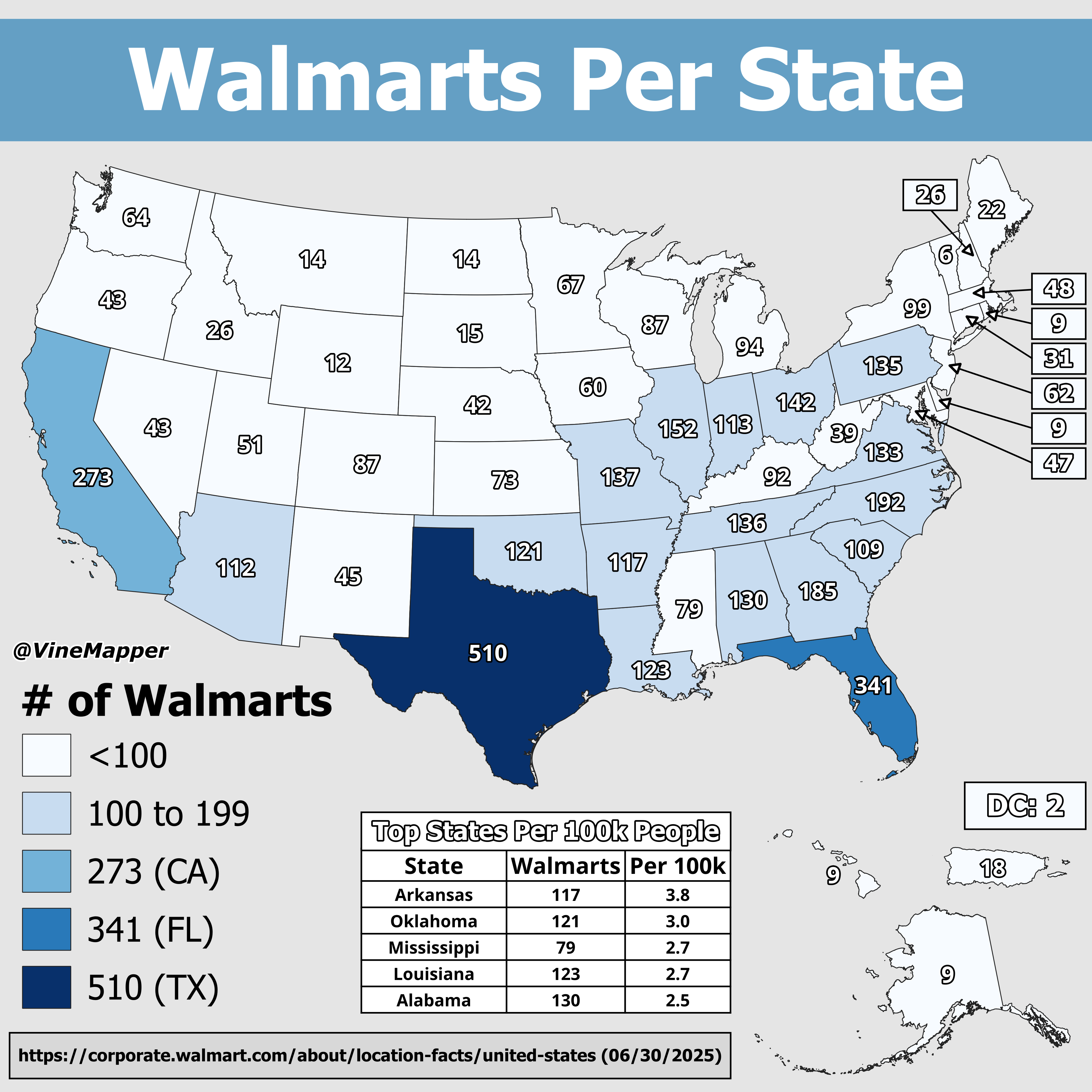Walmarts Per 100k People Map


Alex Cartwright
Senior Cartographer & GIS Specialist
Alex Cartwright is a renowned cartographer and geographic information systems specialist with over 15 years of experience in spatial analysis and data...
Geographic Analysis
What This Map Shows
The "Walmarts Per 100k People Map" provides a striking visualization of the distribution of Walmart stores across various states in the United States, represented as the number of stores per 100,000 residents. This map not only highlights where these retail giants are most concentrated but also offers insight into the socio-economic landscapes of different regions. It prompts intriguing questions about consumer behavior, local economies, and regional demographics.
Interestingly, Walmart has long been a staple in American retail, and its presence can often reflect the economic vitality of a state. As we delve deeper into the topic, we’ll explore the broader implications of Walmart's distribution beyond mere numbers.
Deep Dive into Walmart's Presence in the U.S.
Walmart, founded in 1962, has grown into one of the largest retail chains in the world, with thousands of locations across the U.S. The company's business model thrives on offering low prices and a broad selection of goods, from groceries to electronics. As of recent data, there are approximately 4,700 Walmart stores in the U.S., with the highest concentrations found in states like Texas, Florida, and California.
The map indicates that Walmart's presence is particularly robust in rural and suburban areas where it often serves as the primary shopping destination for residents. Have you ever wondered why that might be? In many smaller towns, Walmart provides essential services that may not be available otherwise, acting as both a grocery store and a department store. In fact, in some communities, a Walmart store can become a key economic driver, providing jobs and attracting other businesses to the area.
However, the distribution of Walmart stores is not uniform across the nation. Regions with higher populations, such as the Northeast and parts of the West Coast, have fewer stores per capita compared to more rural areas. This situation raises important discussions about urban planning and the impact of large retailers on local economies. For instance, in urban areas, the presence of multiple grocery and retail options can limit Walmart’s dominance, while in rural areas, the absence of competition can lead to higher store density.
Additionally, Walmart’s expansion strategies have faced criticism in some circles. Community advocates often argue that the arrival of a Walmart can lead to the decline of local businesses. In contrast, supporters highlight the benefits of job creation and lower prices. The balance between these perspectives is a key consideration when analyzing the map and its implications for local economies and communities.
Regional Analysis
When examining the map regionally, distinct patterns emerge. For example, in the South, states like Arkansas and Mississippi show a significantly higher number of Walmarts per 100,000 people. This is partly due to Walmart’s roots in Arkansas, where the company was founded. In these states, Walmart stores are integral to the community, often providing affordable shopping options in economically disadvantaged areas.
Conversely, in states like New York and New Jersey, the number of Walmarts per capita is considerably lower. This disparity can be attributed to the dense urban environments that favor smaller grocery chains and specialty stores. Interestingly, as we move towards the Midwest, states such as Indiana and Ohio exhibit a moderate number of Walmarts, reflecting a balance between urban centers and rural communities.
In the Western U.S., states like California showcase a varied landscape. Urbanized areas such as Los Angeles have fewer Walmarts per capita due to the presence of numerous alternative retail options, while more rural areas in Northern California see a higher concentration of stores, emphasizing the diversity within the state.
Significance and Impact
Understanding the distribution of Walmarts across states is crucial for grasping the dynamics of American retail and its broader economic implications. The locations of these stores can serve as indicators of consumer trends, economic health, and even social structures within communities. For policymakers and urban planners, the presence of Walmart might influence decisions regarding local business support, zoning regulations, and economic development strategies.
Moreover, as e-commerce continues to rise, Walmart has also adapted its strategy, focusing on online sales and delivery services. This shift could alter the future landscape of retail, making it essential for analysts to monitor these trends closely.
In conclusion, the "Walmarts Per 100k People Map" not only illustrates the physical presence of this retail giant but also prompts us to consider the economic and social ramifications associated with its distribution. As we continue to observe the changing retail landscape, the implications of Walmart's presence on local economies and communities will remain a vital topic of discussion for years to come.
Visualization Details
- Published
- August 19, 2025
- Views
- 186
Comments
Loading comments...